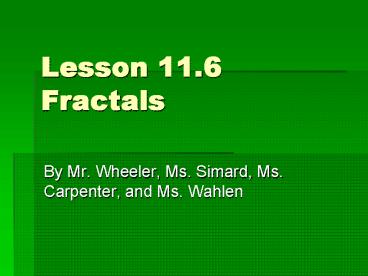Lesson 11'6 Fractals PowerPoint PPT Presentation
1 / 10
Title: Lesson 11'6 Fractals
1
Lesson 11.6Fractals
- By Mr. Wheeler, Ms. Simard, Ms. Carpenter, and
Ms. Wahlen
2
Vocabulary
- Fractal- A geometric object that exhibits some
type of self-similarity - Self-similarity- The property, possessed by
fractals, that every subdivision of the fractal
has a structure similar to the structure as a
whole - Iteration- The repetitive process of the same rule
3
Key Concepts
- Fractals can be created by repeating the same
process over and over. - The Menger sponge, is created by starting with a
certain shape (a cube) and changing it according
to a certain rule (removing a part of the cube). - The same rule is applied to the newly changed
shape and the process continued in an iteration.
4
Menger Sponge
- The structure of the object always looks the
same, whether seen in a highly magnified view,
from a moderate distance, or from far away. - If you were to cut off a small cube-shaped
portion and examine it, the piece would be a
miniature copy of the entire sponge.
5
Sierpenski Gasket
- The Sierpenski gasket is created by repeatedly
applying a single rule to an initial shape. - Rules
- Start with a solid triangle and find the midpoint
of each side. - Iteration 1- Connect the midpoints of the sides
to form four congruent isosceles triangles in the
interior of the original. Remove the center
triangle. - Each new iteration is performed on the remaining
triangles.
6
Fractal Dimension
- Take a 1 x 1 x 1 cube and double its length,
width, and height. - How many copies of the original size cube do you
get? - Doubling the side creates eight copies.
7
Fractal Dimension
- The dimension of the figure is the exponent of
the number of sides. - When you double the sides and create a similar
figure, you write the number of copies as a power
of 2 and the exponent will be the dimension.
8
Examples in Nature
- In a river and its tributaries, every tributary
has its own tributaries so that it has the same
design as the river but on a smaller scale - The branching of trees and their roots
- Blood vessels, nerves, and bronchioles in the
human body - The distribution of galaxies in the universe
9
Bibliography
- Schultz, James E., Kathleen A. Hollowell, Wade
Ellis, and Paul A. Kennedy. Holt Geometry. Holt,
Rinehart, and Winston, 2004. 738-745. - Lanius, Cynthia. "Fractals." 2007. 16 May 2007
lthttp//math.rice.edu/lanius/frac/gt. - "fractal." McGraw-Hill Encyclopedia of Science
and Technology. The McGraw-Hill Companies, Inc.,
2005. Answers.com 16 May. 2007.
http//www.answers.com/topic/fractal
10
The End

